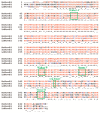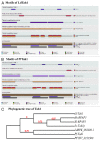Identification of R2TP complex of Leishmania donovani and Plasmodium falciparum using genome wide in-silico analysis
- PMID: 24505500
- PMCID: PMC3913666
- DOI: 10.4161/cib.26005
Identification of R2TP complex of Leishmania donovani and Plasmodium falciparum using genome wide in-silico analysis
Abstract
Recently discovered R2TP complex is an important multiprotein complex involved in multiple cellular process like snoRNP biogenesis, PIKK signaling, RNA polymerase II assembly and apoptosis. Within R2TP complex, Pih1 tightly interacts with Rvb1/Rvb2 and with Tah1 to form R2TP macromolecular complex. R2TP complex further interacts with Hsp90 to form R2TP-Hsp90 complex, which has been found critical in many cellular process. The genome wide screening of Leishmania donovani and Plasmodium falciparum led to the identification of RuvB like1, RuvB like 2, Pih1, and Tah1. Therefore, we speculate that this complex is also important for these parasites as in the yeast. The detailed analysis of crucial components of R2TP complex, Ld-RuvB like 1, and Ld-RuvB like 2, revealed the presence of characteristic motifs like DNA binding motif and ATPase motifs. Hsp90 is also reported from Leishmania donovani and Plasmodium falciparum suggesting that the R2TP complex further interacts with Hsp90 to form R2TP-Hsp90 complex. Recently it has been discovered that RuvB like proteins are overexpressed in many cancers and their ATPase activity is crucial for cancer cell proliferation and the human RuvBs have been proposed as suitable drug target for cancer. Similarly one of the Plasmodium falciparum RuvB like protein (PfRuvB3) has been found to be specific to the stage where nuclear division led multiplication of parasite take place. Considering all these it seems that the R2TP complex may be playing some critical role both in the cancer cell proliferation in human and rapid multiplication of the parasites Leishmania donovani and Plasmodium falciparum.
Keywords: AAA+ enzyme; ATPase; Pih1; Pontin; Reptin; RuvB like protein; Tah1.
Figures








Similar articles
-
RPAP3 C-Terminal Domain: A Conserved Domain for the Assembly of R2TP Co-Chaperone Complexes.Cells. 2020 May 6;9(5):1139. doi: 10.3390/cells9051139. Cells. 2020. PMID: 32384603 Free PMC article. Review.
-
Proteomic and Genomic Analyses of the Rvb1 and Rvb2 Interaction Network upon Deletion of R2TP Complex Components.Mol Cell Proteomics. 2016 Mar;15(3):960-74. doi: 10.1074/mcp.M115.053165. Epub 2016 Feb 1. Mol Cell Proteomics. 2016. PMID: 26831523 Free PMC article.
-
Plasmodium falciparum RuvB2 translocates in 5'-3' direction, relocalizes during schizont stage and its enzymatic activities are up regulated by RuvB3 of the same complex.Biochim Biophys Acta. 2013 Dec;1834(12):2795-811. doi: 10.1016/j.bbapap.2013.10.010. Epub 2013 Oct 24. Biochim Biophys Acta. 2013. PMID: 24161468
-
The R2TP chaperone complex: its involvement in snoRNP assembly and tumorigenesis.Biomol Concepts. 2014 Dec;5(6):513-20. doi: 10.1515/bmc-2014-0028. Biomol Concepts. 2014. PMID: 25429602 Review.
-
The R2TP complex: discovery and functions.Biochim Biophys Acta. 2012 Jan;1823(1):101-7. doi: 10.1016/j.bbamcr.2011.08.016. Epub 2011 Sep 8. Biochim Biophys Acta. 2012. PMID: 21925213 Review.
Cited by
-
Reptin regulates DNA double strand breaks repair in human hepatocellular carcinoma.PLoS One. 2015 Apr 15;10(4):e0123333. doi: 10.1371/journal.pone.0123333. eCollection 2015. PLoS One. 2015. PMID: 25875766 Free PMC article.
-
Heat Shock Proteins of Malaria: Highlights and Future Prospects.Adv Exp Med Biol. 2021;1340:237-246. doi: 10.1007/978-3-030-78397-6_10. Adv Exp Med Biol. 2021. PMID: 34569028
-
Plasmodium falciparum R2TP complex: driver of parasite Hsp90 function.Biophys Rev. 2019 Dec;11(6):1007-1015. doi: 10.1007/s12551-019-00605-3. Epub 2019 Nov 16. Biophys Rev. 2019. PMID: 31734827 Free PMC article. Review.
-
Hsp90 and Associated Co-Chaperones of the Malaria Parasite.Biomolecules. 2022 Jul 22;12(8):1018. doi: 10.3390/biom12081018. Biomolecules. 2022. PMID: 35892329 Free PMC article. Review.
-
Inhibitors of the Plasmodium falciparum Hsp90 towards Selective Antimalarial Drug Design: The Past, Present and Future.Cells. 2021 Oct 22;10(11):2849. doi: 10.3390/cells10112849. Cells. 2021. PMID: 34831072 Free PMC article. Review.
References
-
- Zhao R, Kakihara Y, Gribun A, Huen J, Yang G, Khanna M, Costanzo M, Brost RL, Boone C, Hughes TR, et al. Molecular chaperone Hsp90 stabilizes Pih1/Nop17 to maintain R2TP complex activity that regulates snoRNA accumulation. J Cell Biol. 2008;180:563–78. doi: 10.1083/jcb.200709061. - DOI - PMC - PubMed
-
- Boulon S, Pradet-Balade B, Verheggen C, Molle D, Boireau S, Georgieva M, Azzag K, Robert MC, Ahmad Y, Neel H, et al. HSP90 and its R2TP/Prefoldin-like cochaperone are involved in the cytoplasmic assembly of RNA polymerase II. Mol Cell. 2010;39:912–24. doi: 10.1016/j.molcel.2010.08.023. - DOI - PMC - PubMed
LinkOut - more resources
Full Text Sources
Other Literature Sources
Molecular Biology Databases
Research Materials
